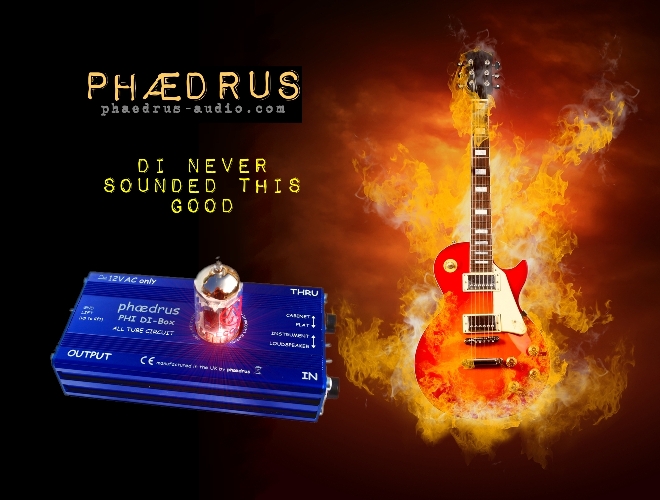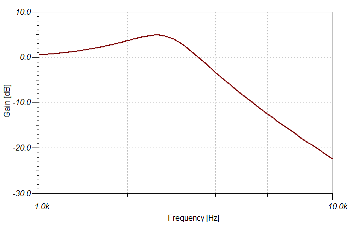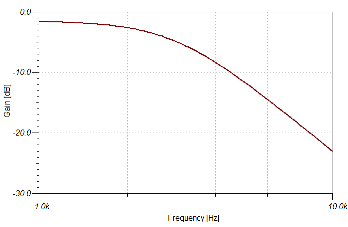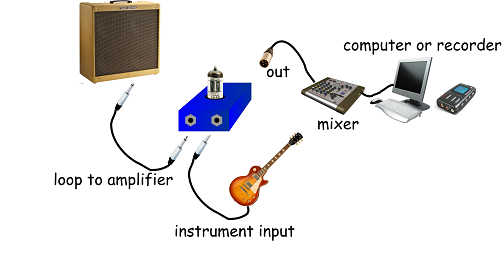
Now that the PHI is integrated in our new, two-channel PHUSION product, the stand-alone PHI is only available to special order. Please contact sales@phaedrus-audio.com for more details.

The PHI is an all-tube, DI-box offering stunning quality for guitar, bass and other instruments with a combination of tube preamp' and transformer output.
But if only things were that simple! The problem is that a passive DI-box, or one incorporating a solid-state input stage, can rarely offer the benefits of a valve preamplifier. Here's why...........
 Guitar pickups are made by winding about 8000 turns of wire on a former or bobbin which surrounds several permanent magnets. The resistance of the wire is relatively low, but the inductance is high and the device therefore has a rising output impedance. The guitar connects to the amplifier by means of a coaxial cable with the inner, signal wire surrounded by the earthy "screen". The construction of this type of cable is not a million miles away from the construction of a capacitor and, unsurprisingly, the coaxial cable displays a significant capacitance at audio frequencies. When the inductive pickup is connected via a capacitive cable, a resonant circuit is formed and we can model this and confirm that this creates a musically-significant resonant-circuit well within the audio band. (Trace right.)
Guitar pickups are made by winding about 8000 turns of wire on a former or bobbin which surrounds several permanent magnets. The resistance of the wire is relatively low, but the inductance is high and the device therefore has a rising output impedance. The guitar connects to the amplifier by means of a coaxial cable with the inner, signal wire surrounded by the earthy "screen". The construction of this type of cable is not a million miles away from the construction of a capacitor and, unsurprisingly, the coaxial cable displays a significant capacitance at audio frequencies. When the inductive pickup is connected via a capacitive cable, a resonant circuit is formed and we can model this and confirm that this creates a musically-significant resonant-circuit well within the audio band. (Trace right.)
This resonant mechanism is one of the principal voicings for the electric guitarist. Three factors affect the resonant circuit: the inductance of the pickup; the capacitance of the cable; and the input impedance of the amplifier: essentially the greater the capacitance and the greater the inductance, the lower the formant frequency. This is why expensive "Custom Wound" pickups and Humbuckers (which have more turns and therefore greater inductance) sound considerably more "chunky" or "fatter" than standard pick-ups. It's the major reason why cables really do sound different; fatter cables (because of their lower capacitance) "singing" better than cheap, thin cables.
 The effect of the amplifier input resistance is to damp the resonant circuit. Valve preamplifiers do not do this because of the common value of 1MΩ for the bias resistor of the first valve. Solid state circuits on the other hand - due to their higher bias currents and lower circuit impedances - can have a major damping effect on the input signal, destroying so much of the character imparted by the resonant circuit (see trace left).
The effect of the amplifier input resistance is to damp the resonant circuit. Valve preamplifiers do not do this because of the common value of 1MΩ for the bias resistor of the first valve. Solid state circuits on the other hand - due to their higher bias currents and lower circuit impedances - can have a major damping effect on the input signal, destroying so much of the character imparted by the resonant circuit (see trace left).
In short, the formant frequency is absolutely crushed and the character of the voice destroyed. Amongst many other reasons, this, so many solid-state guitar-preamplifier designs fail to have the "spring" and "life" of a good valve amplifier: the precious signal is choked before it reaches (literally and metaphorically) first base!
 The Phædrus Audio PHI DI-Box is connected as shown in the diagrams above. Ensure that the "LOUDSPEAKER/INSTRUMENT" switch is in the "INSTRUMENT" position. However, note that feeding the output of the PHI into the studio console will negate some of the benefits of the PHI's unique character. Use a premium-quality microphone preamplifier (such as Phædrus Audio's PHAB) for the very best results.
The Phædrus Audio PHI DI-Box is connected as shown in the diagrams above. Ensure that the "LOUDSPEAKER/INSTRUMENT" switch is in the "INSTRUMENT" position. However, note that feeding the output of the PHI into the studio console will negate some of the benefits of the PHI's unique character. Use a premium-quality microphone preamplifier (such as Phædrus Audio's PHAB) for the very best results.
Phædrues Audio PHI - illustrating Instrument/Loudspeaker and Flat/Cabinet switches
As a general rule, guitar and bass guitar and certain electric pianos and organs rely on the distortions in their amplifiers and loudspeaker-cabinets for the character of their sound. Ideally of course, these instruments need to be captured with microphones, rather than applying a line-level signal to the mixer. However, this is not always possible for a host of reasons including: unacceptable "spill" from other sources; feedback problems; room resonance issues; cabinet "buzz", inadequate microphone response and so on.
In this situation, it is useful to be able to DI, not the output from the instrument, but the signal which drives the loudspeaker. This signal is not modified by the cabinet, but it does have - at least - the character of the amplifier, its tonal modifications and distortion characteristics, imprinted upon it. The Phædrus Audio PHI is able to provide this functionality. However, this loudspeaker signal is of a very much larger amplitude than this signal which leaves the instrument (it has been amplified after all!). It is therefore necessary to attenuate this signal before presenting to the DI circuitry and this is exactly what is done when the "LOUDSPEAKER/INSTRUMENT" switch is moved to the "LOUDSPEAKER" position. The attenuation is -32dB.
When the Phædrus Audio PHI is used in LOUDSPEAKER mode, it is important to observe the correct polarity of the signal fed from the amplifier to the PHI. To avoid short-circuiting the output of the amplifier, the earthy side of the loudspeaker signal MUST be connected to the sleeve of the input jack. In addition, as a precaution, ALWAYS operate with the Ground lift switch in the "LIFT" position when operating the PHI in this way.
The signal from the amplifier may therefore be very greatly improved by the incorporation of an electrical filter which reproduces the electro-acoustic band-pass of the loudspeaker cabinet. To this end, the Phædrus Audio PHI - DI unit, is enhanced by the inclusion within the unit of a loudspeaker-emulation filter which imprints the response of a typical, closed-back, guitar cab' onto the signal. The general response of this filter is illustrated above. Essentially the response falls away gently in the bass, peaks in the mid-treble and falls away rapidly above about 4kHz as shown in the figure.
The adoption of balanced signals, and especially audio transformers should ensure that ground-loops (or earth-loops) should NEVER occur. Certainly the Phædrus Audio PHI, by being both double-insulated and incorporating an earth-free, transformer-balanced output stage can never create a ground-loop in a correctly wired studio. However, connection to an earthed (or grounded) guitar amplifier can cause a circulating current should pin 1 of the output XLR be earthed (grounded) elsewhere in the installation.
This is the role of the GROUND-LIFT switch. It interrupts the connection of pin 1 of the output XLR to the chassis of the PHI and to the sleeve and screen of the guitar wiring. Adjust the position of this switch to eliminate any ground-loop "hums".

Address all mail to sales@phaedrus-audio.com
